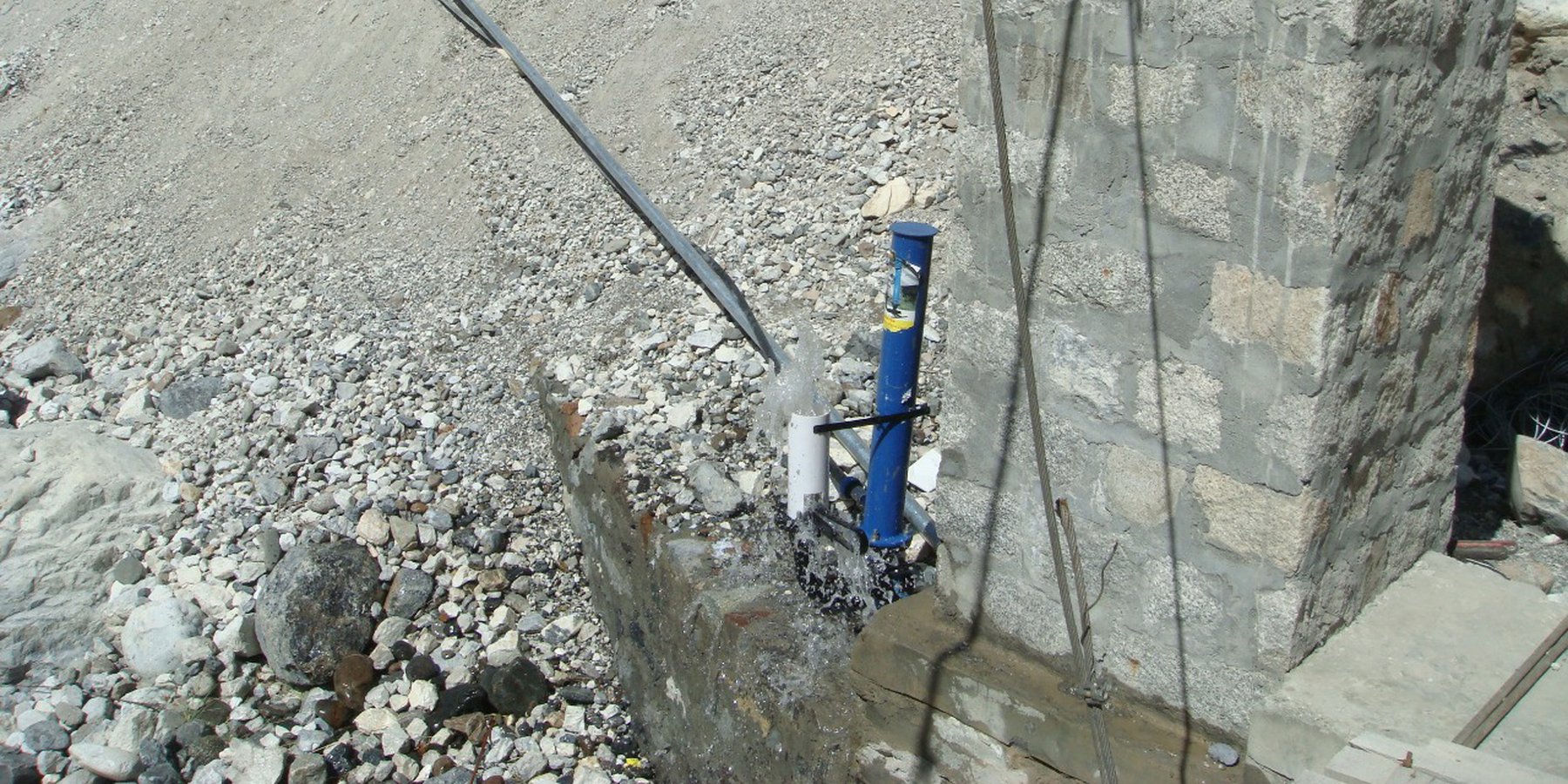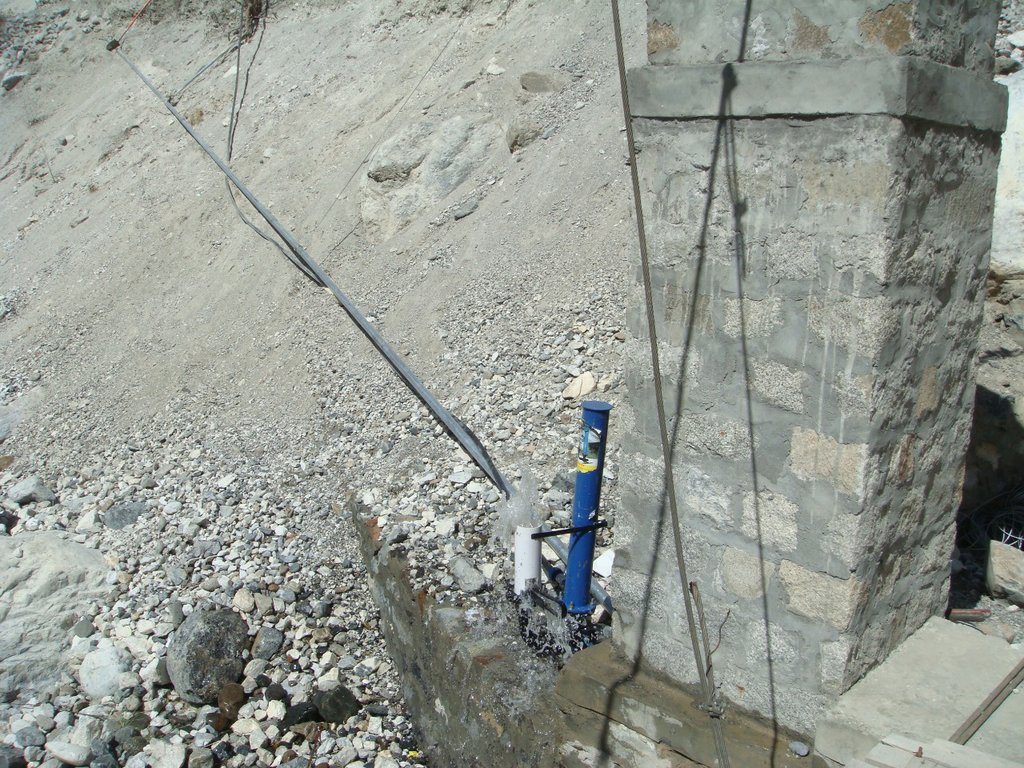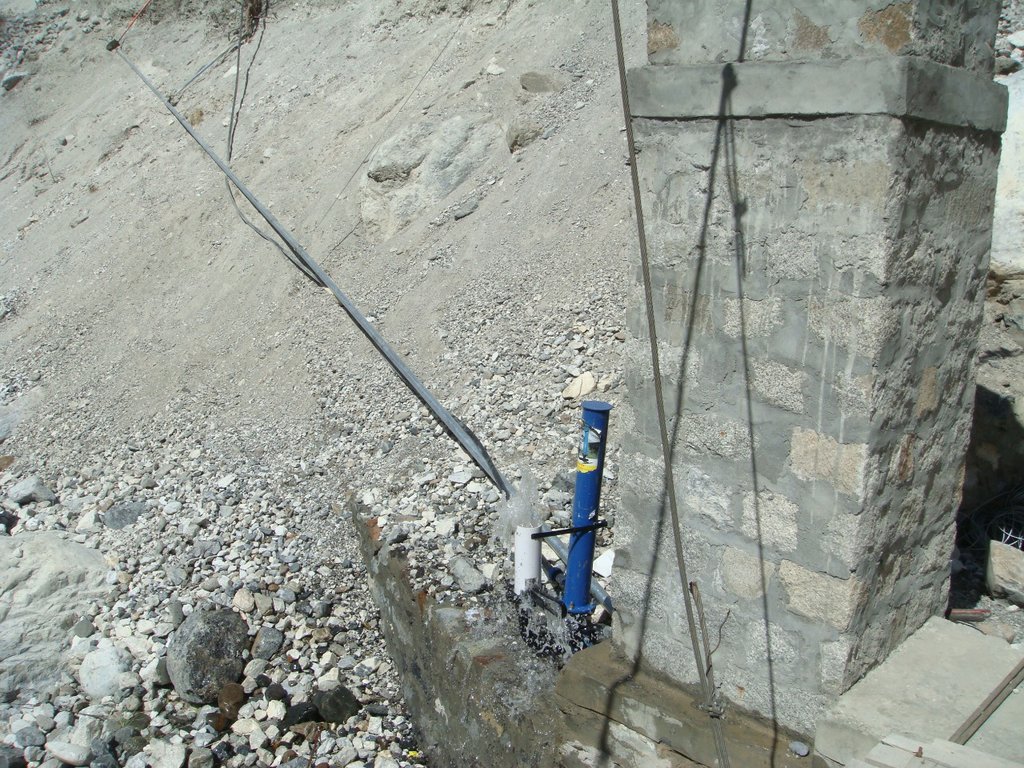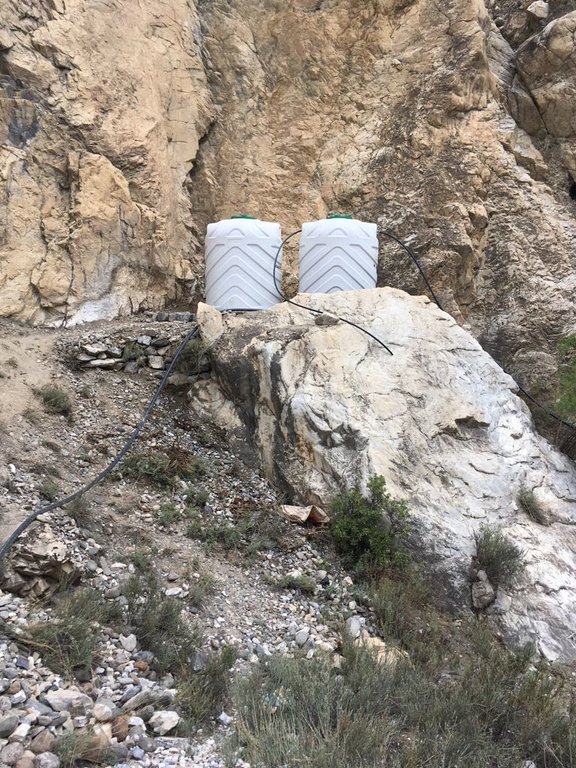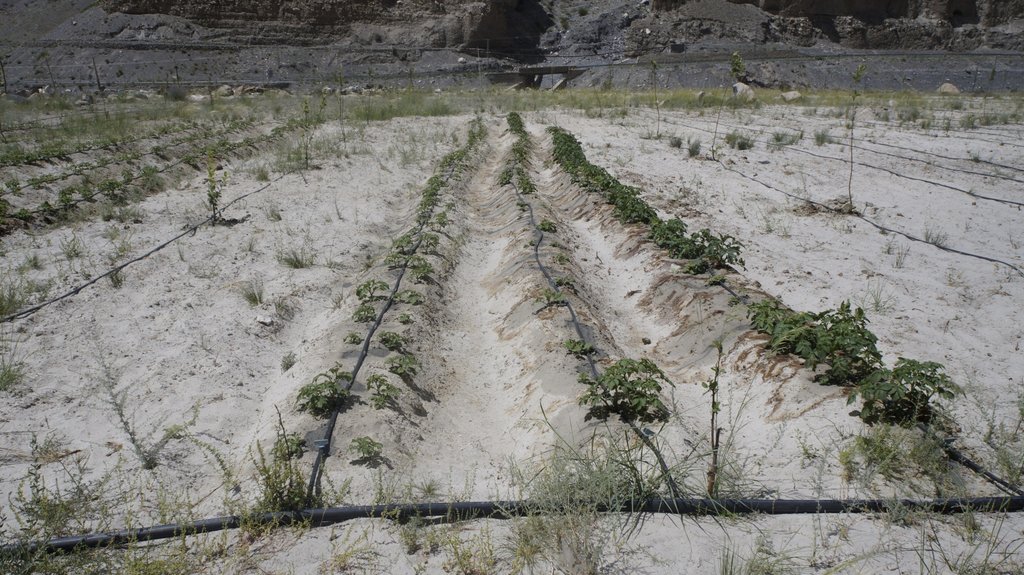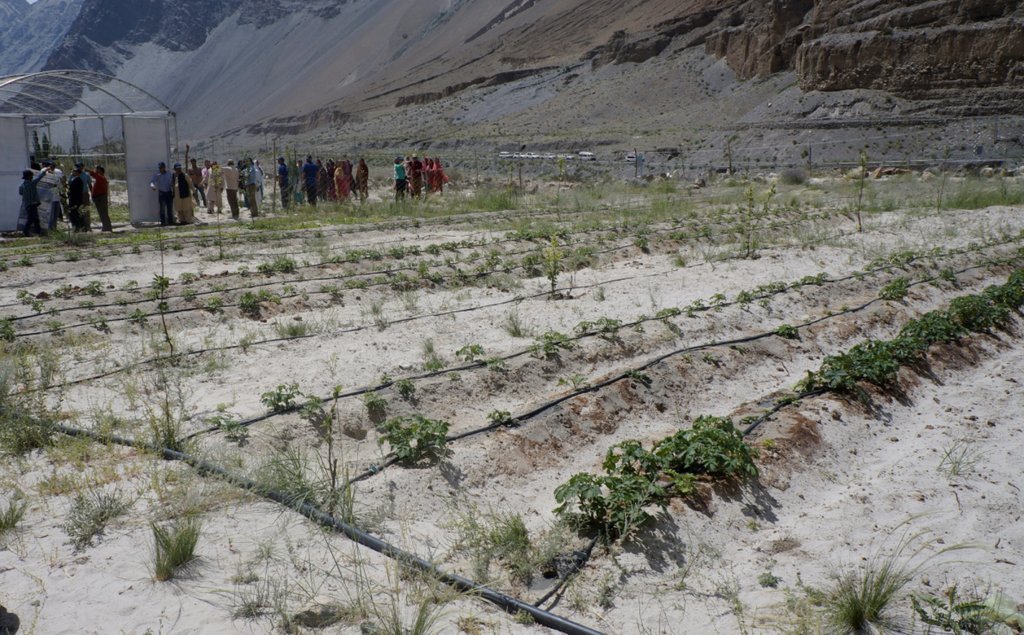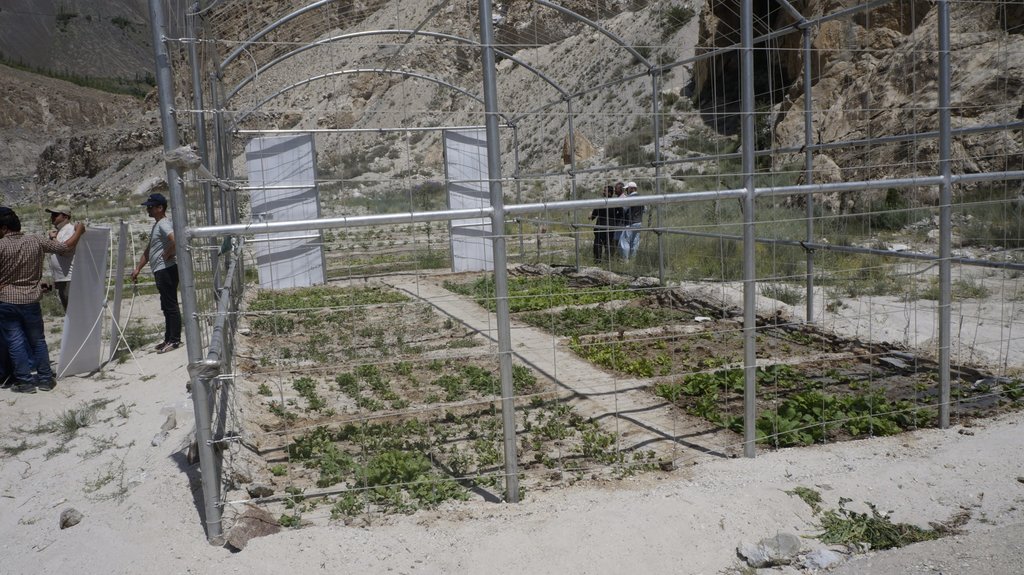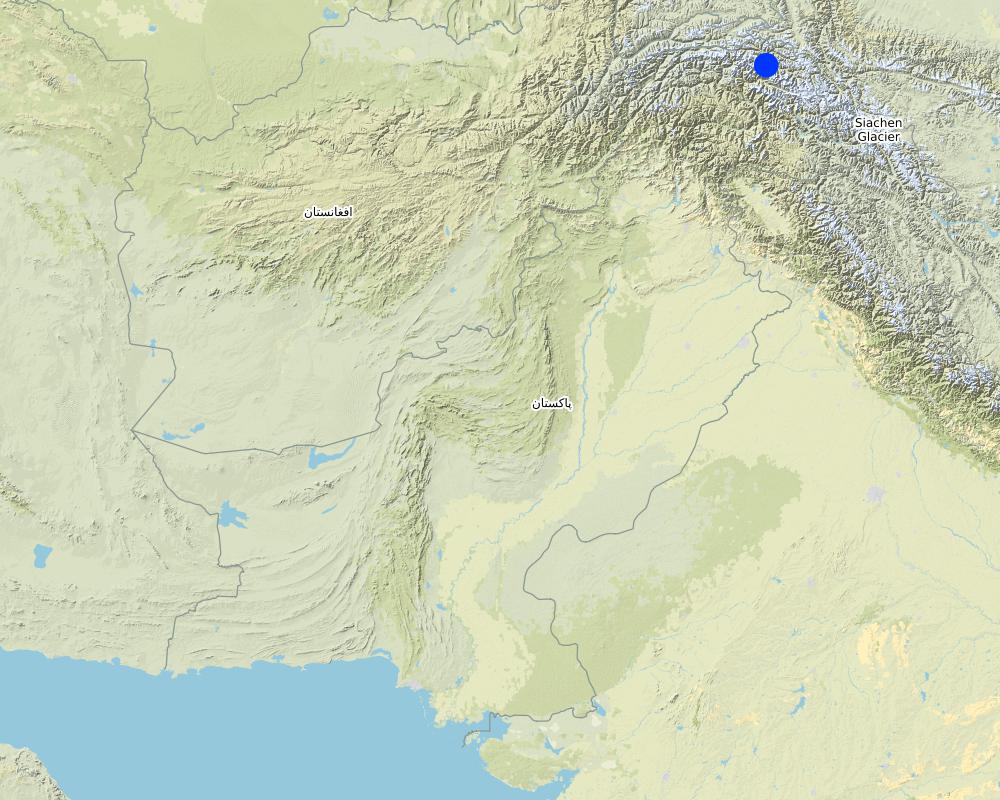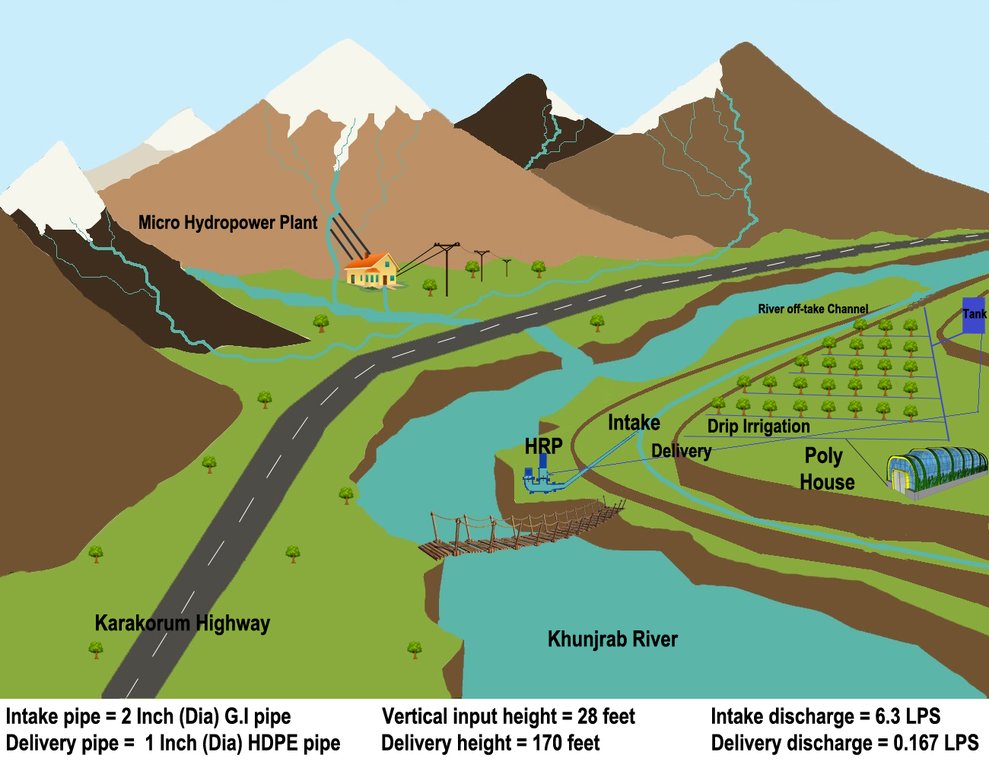Hydraulic Ram Pump assisted river water lifting and application of stored water through drip irrigation for alley cropping [ปากีสถาน]
- ผู้สร้างสรรค์:
- การอัพเดท:
- ผู้รวบรวม: Muhammad Mudassar Maqsood
- ผู้เรียบเรียง: –
- ผู้ตรวจสอบ: Rima Mekdaschi Studer, Ursula Gaemperli
Hydram Pump
technologies_5740 - ปากีสถาน
ดูส่วนย่อย
ขยายทั้งหมด ย่อทั้งหมด1. ข้อมูลทั่วไป
1.2 รายละเอียดที่ติดต่อได้ของผู้รวบรวมและองค์กรที่เกี่ยวข้องในการประเมินและการจัดเตรียมทำเอกสารของเทคโนโลยี
วิทยากรหลัก
ผู้เชี่ยวชาญ SLM:
Maqsood Muhammad Mudassar
International Centre for Integrated Mountain Development (ICIMOD)
ปากีสถาน
ผู้เชี่ยวชาญ SLM:
Shrestha Arun Bhakta
International Centre for Integrated Mountain Development (ICIMOD)
เนปาล
ผู้เชี่ยวชาญ SLM:
Raza Haider
WWF-Pakistan
ปากีสถาน
ผู้เชี่ยวชาญ SLM:
Dhakal Madhav
International Centre for Integrated Mountain Development (ICIMOD)
เนปาล
ผู้เชี่ยวชาญ SLM:
Ali Ajaz
International Centre for Integrated Mountain Development (ICIMOD)
ปากีสถาน
ผู้เชี่ยวชาญ SLM:
Hassan Faizan-ul-
Pakistan Council of Research in Water Resources
ปากีสถาน
ผู้เชี่ยวชาญ SLM:
Karim Fazal
WWF-Pakistan
ปากีสถาน
Consultant:
Azeem-ullah
Azeemullah & Company Chartered Accountants
ปากีสถาน
ผู้เชี่ยวชาญ SLM:
Kundi Rehmat-ullah
GetGreen Tech
ปากีสถาน
ผู้เชี่ยวชาญ SLM:
Shah Ghulam Muhammad
International Centre for Integrated Mountain Development (ICIMOD)
ปากีสถาน
ชื่อของโครงการซึ่งอำนวยความสะดวกในการทำเอกสารหรือการประเมินเทคโนโลยี (ถ้าเกี่ยวข้อง)
Agricultural Water, Energy, and Hazard Management for Improved Livelihood in the Upper Indus Basin, Pakistan (UIB, Pakistan)ชื่อขององค์กรซึ่งอำนวยความสะดวกในการทำเอกสารหรือการประเมินเทคโนโลยี (ถ้าเกี่ยวข้อง)
ICIMOD International Centre for Integrated Mountain Development (ICIMOD) - เนปาล1.3 เงื่อนไขการใช้ข้อมูลที่ได้บันทึกผ่านทาง WOCAT
ผู้รวบรวมและวิทยากรหลักยอมรับเงื่อนไขเกี่ยวกับการใช้ข้อมูลที่ถูกบันทึกผ่านทาง WOCAT:
ใช่
1.4 การเปิดเผยเรื่องความยั่งยืนของเทคโนโลยีที่ได้อธิบายไว้
เทคโนโลยีที่ได้อธิบายไว้นี้เป็นปัญหาของความเสื่อมโทรมโทรมของที่ดินหรือไม่ จึงไม่ได้รับการยอมรับว่าเป็นเทคโนโลยีเพื่อการจัดการที่ดินอย่างยั่งยืน:
ไม่ใช่
2. การอธิบายลักษณะของเทคโนโลยี SLM
2.1 การอธิบายแบบสั้น ๆ ของเทคโนโลยี
คำจำกัดความของเทคโนโลยี:
The water from a contour canal (off-taking from Khunjrab River) was lifted through hydro ram pump to uphill plastic storage and distributed to alley cropping (newly established orchard and vegetable rows) through drip irrigation.
2.2 การอธิบายแบบละเอียดของเทคโนโลยี
คำอธิบาย:
Agriculture, livestock herding and tourism are the major contributors to Gilgit Baltistan economy. The arable land in this region is limited (only 2%) and more than half of which is still barren due to unavailability of irrigation water supplies. The reported dependency of irrigated areas on glacier fed irrigation is more than 90 percent, which now have been fluctuating due to changing climate. This region has been experiencing drastic changes in climate which resulting into lowering of glacier and water related disasters leading towards discontinuity of irrigation water supplies. The electrical power energy options are limited as well as unreliable and in situ replacements are very expensive.
The technological package was applied in arid climate at an elevation ranging from 2340m to 4877 m above sea level. Khyber is located at 36.56o N latitude and 74.79o E longitude. The area receives 150-200 mm annual rain-fall. The population of Khyber village is 1200 residing in 150 houses. Almost 46 percent of population is salaried, 20 percent own business and roughly 19 percent engaged with farming to earn bread and butter for families. The average landholding per household is 3.8 acres out of which 1.25 acre is cultivable waste due to insufficient water supplies and local labor.
To address the above issues, the Indus Basin Initiative (IBI) of International Centre for Integrated Mountain Development (ICIMOD) through its a consortium of local partners including Pakistan Council of Research in Water Resources (PCRWR), Mountain Agriculture Research Centre (MARC) and WWF-Pakistan has been demonstrating the alternative agricultural water management package of practices in lifting water for irrigation using Hydro ram pump. This study also presents the findings based on the experiment/demonstration and testing conducted in the pilot. The pilot site is located in Khyber village of Hunza, Gilgit Baltistan.
The pumping unit comprises a hydro ram pump (which is a zero carbon emission technology and needs no electricty to run, and it is locally customized having 1 inch/25mm out-take pipe) to lift water from a contour channel originating from the Khunjrab River and to carry the water to storage tanks (4000 liters) made up of plastic that has been placed upslope at 175 feet (53,3 m) vertical height from the river. The water from the storage tanks was supplied to alley cropping (apple sapling rows and vegetables rows) through pressure compensating drip irrigation system. The pumping capacity of the pump is 10.2 liters/minute, which is irrigating around 350 apple plants and vegetable rows at 2.5 acre (1ha). The storage tank was kept 45 feet (13,5 m) vertical height from the orchard field. Plan to plant distance and row to row distance of apple was maintained at 15 feet (4,6 m) and 20 (6 m) feet respectively. Drip irrigation system was established for each apple plant, as well as vegetables rows. Pits were constructed for planting apples and later they served also as water harvesting pits /check basins. Gilgit Baltistan chapter of WWF-Pakistan mobilized the local community, while PCRWR and MARC provided technical support to the Khyber Community in establishment of this pilot site. The community youth provided voluntary support during the land preparation, plantation and installation of hydro ram pump as well as drip irrigation system and the uphill storage tanks.
The cost of a complete package including hydro ram pump with accessories, storage tanks, intake and distribution systems, drip irrigation, apple plants and operational expenses for the site was US$ 25, 865 for 2.5 acre (1ha) of land. Women Organization of Khyber village takes care of the maintenance of technological package (fortnightly desilting of drip irrigation and storage tanks and annual repair of hydraulic ram pump). The fruit production has not yet started as it is a newly established farming site. However, seasonal vegetable farming has just started. The produce is small as soil fertility is still building up. Currently, the grown vegetables are being sold or used in the village at household level. However, with higher yield in future, the total income from the farm produce (currenty vegetables only) would be divided equally among the participating 150 households of Khyber Village. A comprehensive cost benefit analysis study has been conducted. It has been envisioned that apple orchard would mature in 4 to 5 years in cold climate of Gojal. By the 6th year, the farm would produce enough to the reach break-event point. The vegetable production has started now and the envisioned annual income is 15,000 PKR (almost 111 USD, if 1 USD=135 PKR).
The community welcomed the new technology and is now planning to outscale it in other areas to bring more land under cultivation. The women organization in the pilot site are positive about the less labourous agricultural activities and foresee to extend the alley cropping under drip irrigation to the rest of 7.5 acres, too. This technology is being dessiminated to different stakeholders including practitioners, policy and decision makers, academia, researchers and local farming communities. For this purpose, exposure field visits and farmers' field days have been arranged by the implementation partners.
2.3 รูปภาพของเทคโนโลยี
2.5 ประเทศภูมิภาค หรือสถานที่ตั้งที่เทคโนโลยีได้นำไปใช้และได้รับการครอบคลุมโดยการประเมินนี้
ประเทศ:
ปากีสถาน
ภูมิภาค/รัฐ/จังหวัด:
Gilgit Baltistan
ข้อมูลจำเพาะเพิ่มเติมของสถานที่ตั้ง :
Khyber Village, Hunza District
ระบุการกระจายตัวของเทคโนโลยี:
- ใช้ ณ จุดที่เฉพาะเจาะจงหรือเน้นไปยังบริเวณพื้นที่ขนาดเล็ก
Is/are the technology site(s) located in a permanently protected area?
ใช่
ถ้าใช่ ระบุ:
The community has protected the site with barbed wire with wooden posts.
Map
×2.6 วันที่การดำเนินการ
ระบุปีที่ใช้:
2018
ถ้าไม่รู้ปีที่แน่นอน ให้ระบุวันที่โดยประมาณ:
- น้อยกว่า 10 ปี (ไม่นานนี้)
2.7 คำแนะนำของเทคโนโลยี
ให้ระบุว่าเทคโนโลยีถูกแนะนำเข้ามาอย่างไร:
- ทางโครงการหรือจากภายนอก
ความคิดเห็น (ประเภทของโครงการ เป็นต้น) :
The Indus Basin Initiative of ICIMOD, with support of Government of Australia under Sustainable Development Investment Portfolio (SDIP), has been developing capacity (resilience to climate change) of vulnerable communities of Gilgit Baltistan through pioneer introduction of contextually new innovative technologies.
3. การจัดประเภทของเทคโนโลยี SLM
3.1 วัตถุประสงค์หลักของเทคโนโลยี
- ปรับปรุงการผลิตให้ดีขึ้น
- ลด ป้องกัน ฟื้นฟู การเสื่อมโทรมของที่ดิน
- ปรับตัวเข้ากับการเปลี่ยนแปลงภูมิอากาศของโลก สภาพภูมิอากาศที่รุนแรงและผลกระทบ
- สร้างผลกระทบทางด้านเศรษฐกิจที่เป็นประโยชน์
- สร้างผลกระทบทางด้านสังคมที่เป็นประโยชน์
3.2 ประเภทของการใช้ที่ดินในปัจจุบันที่ได้นำเทคโนโลยีไปใช้

พื้นที่ปลูกพืช
- การปลูกพืชล้มลุกอายุปีเดียว
- การปลูกไม้ยืนต้น ไม้พุ่ม
Annual cropping - Specify crops:
- vegetables - leafy vegetables (salads, cabbage, spinach, other)
Tree and shrub cropping - Specify crops:
- fruits, other
จำนวนของฤดูเพาะปลูกต่อปี:
- 1
ระบุ:
Only one crop is grown owing to the climate of this area
Is intercropping practiced?
ใช่
If yes, specify which crops are intercropped:
The seasonal vegetables are grown in between two successive apple orchard rows meaning Alley Cropping.
Is crop rotation practiced?
ไม่ใช่
3.3 Has land use changed due to the implementation of the Technology?
Has land use changed due to the implementation of the Technology?
- Yes (Please fill out the questions below with regard to the land use before implementation of the Technology)
Land use mixed within the same land unit:
ไม่ใช่

ที่ดินที่ไม่ให้ผลผลิต
ระบุ:
Barren land
ข้อสังเกต:
Due to unavailability of glacial-melt water, 50% of arable land in Gilgit Baltistan could never be cultivated. Before the interventions were implemented, this land was left barren.
3.4 การใช้น้ำ
การใช้น้ำของที่ดินที่มีการใช้เทคโนโลยีอยู่:
- การชลประทานแบบเต็มรูปแบบ
แสดงความคิดเห็น:
River water is being lifted throuh hydro ram pump, stored in elevated storage tanks and distributed through drip irrigation
3.5 กลุ่ม SLM ที่ตรงกับเทคโนโลยีนี้
- การจัดการด้านชลประทาน (รวมถึงการลำเลียงส่งน้ำ การระบายน้ำ)
- การจัดการน้ำผิวดิน (น้ำพุ แม่น้ำทะเลสาบ ทะเล)
- ประสิทธิภาพด้านพลังงาน
3.6 มาตรการ SLM ที่ประกอบกันเป็นเทคโนโลยี

มาตรการจัดการพืช
- A1: พืช/สิ่งปกคลุมดิน

มาตรการอนุรักษ์ด้วยวิธีพืช
- V1: ต้นไม้และพุ่มไม้คลุมดิน

มาตรการอนุรักษ์ด้วยการจัดการ
- M1: การเปลี่ยนรูปแบบของการใช้ประโยชน์ที่ดิน
3.7 รูปแบบหลักของการเสื่อมโทรมของที่ดินที่ได้รับการแก้ไขโดยเทคโนโลยี

การกัดกร่อนของดินโดยน้ำ
- Wt (Loss of topsoil): การสูญเสียดินชั้นบนหรือการกัดกร่อนที่ผิวดิน

การกัดกร่อนของดินโดยลม
- Et (Loss of topsoil): การสูญเสียดินชั้นบน

การเสื่อมโทรมของน้ำ
- Ha (Aridification): การเกิดความแห้งแล้ง
แสดงความคิดเห็น:
Damage and dysfunction of irrigation canal, due to water related disasters.
3.8 การป้องกัน การลดลง หรือการฟื้นฟูความเสื่อมโทรมของที่ดิน
ระบุเป้าหมายของเทคโนโลยีกับความเสื่อมโทรมของที่ดิน:
- ฟื้นฟูบำบัดที่ดินที่เสื่อมโทรมลงอย่างมาก
แสดงความคิดเห็น:
Due to water access cultivation of before barren land was possible and vegetation cover improved.
4. ข้อมูลจำเพาะด้านเทคนิค กิจกรรมการนำไปปฏิบัติใช้ ปัจจัยนำเข้า และค่าใช้จ่าย
4.1 แบบแปลนทางเทคนิคของเทคโนโลยี
ข้อมูลจำเพาะด้านเทคนิค (แบบแปลนทางเทคนิคของเทคโนโลยี):
Hydro Ram Pump: Locally manufactured with pumping capacity of the pump: 10.2 litres/minute. The intake G.I pipe (2 inch/50mm diameter) of 83 feet (25 m) long is connected to water channel. The vertical difference between hydro ram pump and water channel is 28 feet (25m). The out-take HDPE pipe of (1 inch/25mm diameter) of 200 feet (61m) carries water from hydro ram pump to plastic storages. The vertical distance between hydro ram pump and plastic storage tanks is 175 feet (53 m).
The capacity of storage tank: 4000 litres, location of storage tank: 175 feet height (53m, vertical) from the river and 45 feet height (14m, vertical) from the orchard field.
Drip Irrigation: Surface and pressure compensating. The spacing of dripping points: 15 feet (4.6m). Plant to plant and row to row distance of apple 15 feet (4.6m) and 20 feet (6m) respectively.
ผู้เขียน:
Muhammad Mudassar Maqsood
วันที่:
25/03/2020
4.2 ข้อมูลทั่วไปเกี่ยวกับการคำนวณปัจจัยนำเข้าและค่าใช้จ่าย
ให้ระบุว่าค่าใช้จ่ายและปัจจัยนำเข้าได้รับการคำนวณอย่างไร:
- ต่อหน่วยเทคโนโลยี
โปรดระบุหน่วย:
Technological package at pilot site covering 2.5 acre (1 ha)
ระบุสกุลเงินที่ใช้คำนวณค่าใช้จ่าย:
- USD
ระบุค่าเฉลี่ยของค่าจ้างในการจ้างแรงงานต่อวัน:
US$ 14.5 for skilled person and US$ 7.5 for unskilled person
4.3 กิจกรรมเพื่อการจัดตั้ง
| กิจกรรม | Timing (season) | |
|---|---|---|
| 1. | Site identification in consultation with the communities | March 2017 |
| 2. | Detailed feasibility surveys of the site | May 2017 |
| 3. | Implementation agreement with the community | January 2018 |
| 4. | Installation of hydro ram pump | June 2018 |
| 5. | Installation of storage (plastic tank) with a line filter attached to it for the operation of the drip system and avoid sediment entry into the tank | June 2018 |
| 6. | Digging of pits for plantation of the apple orchard | June 2018 |
| 7. | Laying of drip irrigation systems | June 2018 |
| 8. | Plantation of tubed apple (Kala Kolu variety) it is bought from the local nursery | June 2018 |
| 9. | Training to selected farmers as caretakers of the technologies for its days to day repair and maintenance | August 2018 |
4.4 ค่าใช้จ่ายของปัจจัยนำเข้าที่จำเป็นสำหรับการจัดตั้ง
| ปัจจัยนำเข้า | หน่วย | ปริมาณ | ค่าใช้จ่ายต่อหน่วย | ค่าใช้จ่ายทั้งหมดต่อปัจจัยนำเข้า | %ของค่าใช้จ่ายที่ก่อให้เกิดขึ้นโดยผู้ใช้ที่ดิน | |
|---|---|---|---|---|---|---|
| แรงงาน | Plumbing and technical workers | 1 | 1.0 | 775.0 | 775.0 | 33.0 |
| แรงงาน | Installation charges | 1 | 1.0 | 968.0 | 968.0 | |
| อุปกรณ์ | Ram Pump & Accessories | 1 | 1.0 | 8526.0 | 8526.0 | |
| อุปกรณ์ | Drip Irrigation | 1 | 1.0 | 5813.0 | 5813.0 | |
| อุปกรณ์ | Off-seasonal vegetable tunnel | 1 | 1.0 | 4715.0 | 4715.0 | |
| วัสดุด้านพืช | Apple tree saplings (lumb sum) | 1 | 1.0 | 3165.0 | 3165.0 | |
| ปุ๋ยและสารฆ่า/ยับยั้งการเจริญเติบโตของสิ่งมีชีวิต (ไบโอไซด์) | Compost (250 kg) | 1 | 250.0 | 0.12 | 30.0 | 100.0 |
| อื่น ๆ | Feasibility study | 1 | 1.0 | 1873.0 | 1873.0 | |
| ค่าใช้จ่ายทั้งหมดของการจัดตั้งเทคโนโลยี | 25865.0 | |||||
| Total costs for establishment of the Technology in USD | 25865.0 | |||||
ถ้าผู้ใช้ที่ดินรับภาระน้อยกว่า 100% ของค่าใช้จ่าย ให้ระบุว่าใครเป็นผู้รับผิดชอบส่วนที่เหลือ:
ICIMOD through fundings from Department of Foreign Affairs and Trade under Sustainable Development Investment Portfolio
แสดงความคิดเห็น:
The USD to PKR exchange rate while time of budget transfer was 1 USD=104.50 PKR
4.5 การบำรุงรักษาสภาพหรือกิจกรรมที่เกิดขึ้นเป็นประจำ
| กิจกรรม | ช่วงระยะเวลา/ความถี่ | |
|---|---|---|
| 1. | Repair of hydro ram pump | twice an year |
| 2. | Desiltation of plastic tanks | twice an year |
| 3. | Desiltation of drip irrigation system | once an year |
| 4. | Repair & maintenance of drip irrigation system | once in 2 years |
4.6 ค่าใช้จ่ายของปัจจัยนำเข้าและกิจกรรมที่เกิดขึ้นเป็นประจำที่ต้องการการบำรุงรักษา (ต่อปี)
| ปัจจัยนำเข้า | หน่วย | ปริมาณ | ค่าใช้จ่ายต่อหน่วย | ค่าใช้จ่ายทั้งหมดต่อปัจจัยนำเข้า | %ของค่าใช้จ่ายที่ก่อให้เกิดขึ้นโดยผู้ใช้ที่ดิน | |
|---|---|---|---|---|---|---|
| แรงงาน | Repair of hydro ram pump | 1 | 2.0 | 3.75 | 7.5 | 100.0 |
| แรงงาน | Desiltation of plastic tanks | 1 | 2.0 | 7.5 | 15.0 | 100.0 |
| แรงงาน | Desiltation of drip irrigation system | 1 | 1.0 | 37.0 | 37.0 | 100.0 |
| แรงงาน | Repair & maintenance of drip irrigation system | 1 | 0.5 | 37.0 | 18.5 | 100.0 |
| อุปกรณ์ | Repair of hydro ram pump | 1 | 2.0 | 10.0 | 20.0 | 100.0 |
| อุปกรณ์ | Repair & maintenance of drip irrigation system | 1 | 0.5 | 100.0 | 50.0 | 100.0 |
| วัสดุด้านพืช | Vegetable seeds | 1 | 1.0 | 15.0 | 15.0 | 100.0 |
| ปุ๋ยและสารฆ่า/ยับยั้งการเจริญเติบโตของสิ่งมีชีวิต (ไบโอไซด์) | Diammonium phosphate (DAP) | 1 | 2.0 | 30.0 | 60.0 | 100.0 |
| ปุ๋ยและสารฆ่า/ยับยั้งการเจริญเติบโตของสิ่งมีชีวิต (ไบโอไซด์) | Compost (250 kg) | 1 | 1.0 | 22.0 | 22.0 | 100.0 |
| ค่าใช้จ่ายทั้งหมดของการบำรุงรักษาสภาพเทคโนโลยี | 245.0 | |||||
| Total costs for maintenance of the Technology in USD | 245.0 | |||||
4.7 ปัจจัยสำคัญที่สุดที่มีผลกระทบต่อค่าใช้จ่าย
ปัจจัยสำคัญที่สุดที่มีผลกระทบต่อค่าใช้จ่ายต่างๆ:
Since the most of the material (drip irrigation etc) is imported thus cost varies with foreign currency exchange rates. Moreover, the costs are also higher in Gilgit Baltistan comparing to plains of Pakistan owning to expensive transportation.
5. สิ่งแวดล้อมทางธรรมชาติและของมนุษย์
5.1 ภูมิอากาศ
ฝนประจำปี
- < 250 ม.ม.
- 251-500 ม.ม.
- 501-750 ม.ม.
- 751-1,000 ม.ม.
- 1,001-1,500 ม.ม.
- 1,501-2,000 ม.ม.
- 2,001-3,000 ม.ม.
- 3,001-4,000 ม.ม.
- > 4,000 ม.ม.
ระบุปริมาณน้ำฝนเฉลี่ยรายปี (ถ้ารู้) :หน่วย ม.ม.
150.00
ข้อมูลจำเพาะ/ความคิดเห็นเรื่องปริมาณน้ำฝน:
it varies from 150 mm to 200 mm
ระบุชื่อของสถานีตรวดวัดอากาศที่ใช้อ้างอิงคือ:
Passu ghar
เขตภูมิอากาศเกษตร
- แห้งแล้ง
5.2 สภาพภูมิประเทศ
ค่าเฉลี่ยความลาดชัน:
- ราบเรียบ (0-2%)
- ลาดที่ไม่ชัน (3-5%)
- ปานกลาง (6-10%)
- เป็นลูกคลื่น (11-15%)
- เป็นเนิน (16-30%)
- ชัน (31-60%)
- ชันมาก (>60%)
ธรณีสัณฐาน:
- ที่ราบสูง/ที่ราบ
- สันเขา
- ไหล่เขา
- ไหล่เนินเขา
- ตีนเนิน
- หุบเขา
ระดับความสูง:
- 0-100 เมตร
- 101-500 เมตร
- 501-1,000 เมตร
- 1,001-1,500 เมตร
- 1,501-2,000 เมตร
- 2,001-2,500 เมตร
- 2,501-3,000 เมตร
- 3,001-4,000 เมตร
- > 4,000 เมตร
ให้ระบุถ้าเทคโนโลยีได้ถูกนำไปใช้:
- ไม่เกี่ยวข้อง
5.3 ดิน
ค่าเฉลี่ยความลึกของดิน:
- ตื้นมาก (0-20 ซ.ม.)
- ตื้น (21-50 ซ.ม.)
- ลึกปานกลาง (51-80 ซ.ม.)
- ลึก (81-120 ซ.ม.)
- ลึกมาก (>120 ซ.ม.)
เนื้อดิน (ดินชั้นบน):
- หยาบ/เบา (ดินทราย)
เนื้อดินล่าง (> 20 ซ.ม.ต่ำจากผิวดิน):
- หยาบ/เบา (ดินทราย)
อินทรียวัตถุในดิน:
- ต่ำ (<1%)
5.4 ความเป็นประโยชน์และคุณภาพของน้ำ
ระดับน้ำใต้ดิน:
5-50 เมตร
น้ำไหลบ่าที่ผิวดิน:
ดี
คุณภาพน้ำ (ที่ยังไม่ได้บำบัด):
เป็นน้ำใช้เพื่อการเกษตรเท่านั้น (การชลประทาน)
Water quality refers to:
surface water
ความเค็มของน้ำเป็นปัญหาหรือไม่:
ไม่ใช่
กำลังเกิดน้ำท่วมในพื้นที่หรือไม่:
ใช่
บ่อยครั้ง:
บ่อยครั้ง
ความคิดเห็นและข้อมูลจำเพาะเพิ่มเติมเรื่องคุณภาพและปริมาณน้ำ:
Water is available in the river but fields are higher up than river
5.5 ความหลากหลายทางชีวภาพ
ความหลากหลายทางชนิดพันธุ์:
- ต่ำ
ความหลากหลายของแหล่งที่อยู่:
- ต่ำ
5.6 ลักษณะของผู้ใช้ที่ดินที่นำเทคโนโลยีไปปฏิบัติใช้
อยู่กับที่หรือเร่ร่อน:
- กึ่งเร่ร่อน
แนวทางการตลาดของระบบการผลิต:
- เพื่อการยังชีพ (หาเลี้ยงตนเอง)
รายได้ที่มาจากนอกฟาร์ม:
- > 50% ของรายได้ทั้งหมด
ระดับของความมั่งคั่งโดยเปรียบเทียบ:
- พอมีพอกิน
เป็นรายบุคคล/ครัวเรือน:
- กลุ่ม/ชุมชน
ระดับของการใช้เครื่องจักรกล:
- งานที่ใช้แรงกาย
- การใช้กำลังจากสัตว์
เพศ:
- หญิง
อายุของผู้ใช้ที่ดิน:
- ผู้เยาว์
- วัยกลางคน
ระบุลักษณะอื่นๆที่เกี่ยวข้องของผู้ใช้ที่ดิน:
This pilot site has been handed over to women organization of Khyber village, so women are managing all agricultural activities at this site.
5.7 Average area of land used by land users applying the Technology
- < 0.5 เฮกตาร์
- 0.5-1 เฮกตาร์
- 1-2 เฮกตาร์
- 2-5 เฮกตาร์
- 5-15 เฮกตาร์
- 15-50 เฮกตาร์
- 50-100 เฮกตาร์
- 100-500 เฮกตาร์
- 500-1,000 เฮกตาร์
- 1,000-10,000 เฮกตาร์
- >10,000 เฮกตาร์
พิจารณาว่าเป็นขนาดเล็ก กลาง หรือขนาดใหญ่ (ซึ่งอ้างอิงถึงบริบทระดับท้องถิ่น):
- ขนาดเล็ก
5.8 กรรมสิทธิ์ในที่ดิน สิทธิในการใช้ที่ดินและสิทธิในการใช้น้ำ
กรรมสิทธิ์ในที่ดิน:
- เป็นแบบชุมชนหรือหมู่บ้าน
- รายบุคคล ได้รับสิทธิครอบครอง
สิทธิในการใช้ที่ดิน:
- เกี่ยวกับชุมชน (ถูกจัดระเบียบ)
- รายบุคคล
สิทธิในการใช้น้ำ:
- รายบุคคล
Are land use rights based on a traditional legal system?
ใช่
แสดงความคิดเห็น:
Most of the uncultivated land is communal, community decides uses of the land
5.9 การเข้าถึงบริการและโครงสร้างพื้นฐาน
สุขภาพ:
- จน
- ปานกลาง
- ดี
การศึกษา:
- จน
- ปานกลาง
- ดี
ความช่วยเหลือทางด้านเทคนิค:
- จน
- ปานกลาง
- ดี
การจ้างงาน (เช่น ภายนอกฟาร์ม):
- จน
- ปานกลาง
- ดี
ตลาด:
- จน
- ปานกลาง
- ดี
พลังงาน:
- จน
- ปานกลาง
- ดี
ถนนและการขนส่ง:
- จน
- ปานกลาง
- ดี
น้ำดื่มและการสุขาภิบาล:
- จน
- ปานกลาง
- ดี
บริการด้านการเงิน:
- จน
- ปานกลาง
- ดี
6. ผลกระทบและสรุปคำบอกกล่าว
6.1 ผลกระทบในพื้นที่ดำเนินการ (On-site) จากการใช้เทคโนโลยี
ผลกระทบทางด้านเศรษฐกิจและสังคม
การผลิต
การผลิตพืชผล
แสดงความคิดเห็น/ระบุ:
The fruit production has not yet started as it is a newly established farming site. However, seasonal vegetable farming has just started. The produce is small as the soil nutrition building is still in process. Currently, the grown vegetables are being sold or used in the village at household level.
พื้นที่สำหรับการผลิต
หลังจาก SLM:
2.5 acres/1ha
แสดงความคิดเห็น/ระบุ:
Production area increased as uncultivated land has been brought under cultivation.
ความเป็นประโยชน์และคุณภาพของน้ำ
การมีน้ำไว้ให้สำหรับการชลประทาน
จำนวนก่อน SLM:
0
หลังจาก SLM:
14,688 litres per day
แสดงความคิดเห็น/ระบุ:
Irrigation water availability increased with innovative technological packages to previously barren land
รายได้และค่าใช้จ่าย
รายได้จากฟาร์ม
ภาระงาน
แสดงความคิดเห็น/ระบุ:
Automized irrigation has decreased labour
ผลกระทบทางด้านเศรษฐกิจและสังคมอื่น ๆ
Organic vegetables for household consumption
ผลกระทบด้านสังคมวัฒนธรรมอื่น ๆ
การใช้ที่ดิน / สิทธิในการใช้น้ำ
แสดงความคิดเห็น/ระบุ:
Women have been allocated 10 acre arable land (pilot area) for their agricultural area. Out of this 10 acres, ICIMOD with its partners and community organization has brought 2.5 acres under cultivation.
สถาบันของชุมชน
แสดงความคิดเห็น/ระบุ:
Community institution (village development organizations) strengthened due to the approach of farming in a group.
ผลกระทบด้านนิเวศวิทยา
ดิน
ความชื้นในดิน
แสดงความคิดเห็น/ระบุ:
Improved soil moisture as a result of water harvesting pits, mulching and efficient drip irrigation.
สิ่งปกคลุมดิน
แสดงความคิดเห็น/ระบุ:
Soil cover improved due to vegetation
การสูญเสียดิน
แสดงความคิดเห็น/ระบุ:
Reduced soil loss ( from wind and water erosion) due to application of mulch and also due to vegetation cover and above-ground biomass.
6.2 ผลกระทบนอกพื้นที่ดำเนินการ (Off-site) จากการใช้เทคโนโลยี
ผลกระทบของก๊าซเรือนกระจก
แสดงความคิดเห็น/ระบุ:
The intervention has introduced block orchard technology which will help to reduce the impacts of CO2 emmissions from vehicles along the China Pakistan Economic Corridor. Moreover, the water management interventions being used are also climate smart.
6.3 การเผชิญและความตอบสนองของเทคโนโลยีต่อการเปลี่ยนแปลงสภาพภูมิอากาศที่ค่อยเป็นค่อยไป และสภาพรุนแรงของภูมิอากาศ / ภัยพิบัติ (ที่รับรู้ได้โดยผู้ใช้ที่ดิน)
สภาพรุนแรงของภูมิอากาศ (ภัยพิบัติ)
ภัยพิบัติทางอุตุนิยมวิทยา
| เทคโนโลยีมีวิธีการรับมืออย่างไร | |
|---|---|
| พายุหิมะประจำท้องถิ่น | ดี |
| พายุลมประจำท้องถิ่น | ดี |
ภัยพิบัติจากสภาพภูมิอากาศ
| เทคโนโลยีมีวิธีการรับมืออย่างไร | |
|---|---|
| คลื่นความหนาว | ดี |
| สภาพอากาศฤดูหนาวที่รุนแรง | ดี |
ภัยพิบัติจากน้ำ
| เทคโนโลยีมีวิธีการรับมืออย่างไร | |
|---|---|
| น้ำท่วมตามปกติ (แม่น้ำ) | ดี |
| น้ำท่วมฉับพลัน | ดี |
| ดินถล่ม | ไม่ค่อยดี |
ผลลัพธ์ตามมาที่เกี่ยวข้องกับภูมิอากาศอื่น ๆ
ผลลัพธ์ตามมาที่เกี่ยวข้องกับภูมิอากาศอื่น ๆ
| เทคโนโลยีมีวิธีการรับมืออย่างไร | |
|---|---|
| ช่วงการปลูกพืชที่ขยายออกไป | ดี |
6.4 การวิเคราะห์ค่าใช้จ่ายและผลประโยชน์ที่ได้รับ
ผลประโยชน์ที่ได้รับเปรียบเทียบกับค่าใช้จ่ายในการจัดตั้งเป็นอย่างไร (จากมุมมองของผู้ใช้ที่ดิน)
ผลตอบแทนระยะสั้น:
ด้านบวกเล็กน้อย
ผลตอบแทนระยะยาว:
ด้านบวกอย่างมาก
ผลประโยชน์ที่ได้รับเปรียบเทียบกับค่าใช้จ่ายในการบำรุงรักษาหรือต้นทุนที่เกิดขึ้นซ้ำอีก เป็นอย่างไร (จากมุมมองของผู้ใช้ที่ดิน)
ผลตอบแทนระยะสั้น:
เป็นกลางหรือสมดุล
ผลตอบแทนระยะยาว:
ด้านบวกอย่างมาก
แสดงความคิดเห็น:
A comprehensive cost benefit analysis study has been conducted. It has been envisioned that apple orchard would mature in 4 to 5 years in cold climate of Gojal. By the 6th year, the farm would enough produce the reach break-event point. The vegetable production has started now and the envisioned annual income is 15,000 PKR (almost 111 USD,, if 1 USD=135 PKR).
6.5 การปรับตัวของเทคโนโลยี
- 1-10%
Of all those who have adopted the Technology, how many did so spontaneously, i.e. without receiving any material incentives/ payments?
- 0-10%
แสดงความคิดเห็น:
ICIMOD and its consortium of partners piloted the technology in this region at one village only in District Hunza, which was further out-scaled by WWF under UNDP project to six other districts (one site per district) and now federal government has awarded a project to Government of Gilgit Baltistan (National Programme for Enhancing Command Area of Small and Mini Dams in Barani Areas of Pakistan, Gilgit Baltistan Component) to upscale the piloted technology to all districts (atleast 5 sites per districts) which means 50 hydro ram pump cum drip irrigation models. This project will cost 2.6 million USD.
6.6 การปรับตัว
เทคโนโลยีได้รับการปรับเปลี่ยนเมื่อเร็วๆนี้ เพื่อให้ปรับตัวเข้ากับสภาพที่กำลังเปลี่ยนแปลงหรือไม่:
ไม่ใช่
6.7 จุดแข็ง / ข้อได้เปรียบ / โอกาสของเทคโนโลยี
| จุดแข็ง / ข้อได้เปรียบ / โอกาสในทัศนคติของผู้ใช้ที่ดิน |
|---|
| The hydro ram pump assisted river water lifting integrated with drip irrigation is the first of its kind in the upper Indus basin. The system is simple and anyone once trained can operate it. It will contribute to nearly 40% of the additional income of the Khyber Village |
| The technological package is environmentally friendly and are effective adaptation measures in the context of climate change. |
| Women are involved in agricultural activities and this intervention has provided them relief. Women are now generating seasonal income from growing seasonal and off-seasonal vegetables. |
| จุดแข็ง / ข้อได้เปรียบ / โอกาสในทัศนคติของผู้รวบรวมหรือวิทยากรหลัก |
|---|
| The first innovative technological package in Gilgit Baltistan that is climate-resilient as compare to traditional practices. |
| Water application through drip irrigation is very efficient as compared to flood irrigation. |
| The technological package can last more than 20 years. Maintenance cost is nominal. |
| As women are predominantly responsible for farming activities, improved water access and application through drip reduces their work-load and frees up time for other activities |
6.8 จุดอ่อน / ข้อเสียเปรียบ / ความเสี่ยงของเทคโนโลยีและวิธีการแก้ไข
| จุดอ่อน / ข้อเสียเปรียบ / ความเสี่ยงในทัศนคติของผู้ใช้ที่ดิน | มีวิธีการแก้ไขได้อย่างไร |
|---|---|
| Drip irrigation and parts of solar panel may not be available locally. | A spare parts should be made available locally for immediate replacement as and when required. |
| The investment cost is high. | Explain cost-benefit analysis to aware farmers that the benefit is high in the long run. |
7. การอ้างอิงและการเชื่อมต่อ
7.1 วิธีการและแหล่งข้อมูล
- ไปเยี่ยมชมภาคสนาม การสำรวจพื้นที่ภาคสนาม
Field visits was done several times as this was a part of the project activity. Cost benefit analysis was done in 2020.
- การสัมภาษณ์กับผู้ใช้ที่ดิน
7.2 การอ้างอิงถึงสิ่งตีพิมพ์
หัวข้อ, ผู้เขียน, ปี, หมายเลข ISBN:
Collaboration Strengthens Climate Resiliency of Upper Gojal Gilgit Mountain Villages in The Upper Indus Basin, CIMOD, 2017
ชื่อเรื่อง ผู้เขียน ปี ISBN:
https://www.icimod.org/collaboration-strengthens-climate-resiliency-of-upper-gojal-gilgit-mountain-villages-in-the-upper-indus-basin/
7.3 Links to relevant online information
ชื่อเรื่องหรือคำอธิบาย:
Zero-carbon water pumps turn Pak barren mountains green, Syed Abu Bakar, 2020
URL:
https://www.thenews.com.pk/print/636825-zero-carbon-water-pumps-turn-pak-barren-mountains-green
7.4 General comments
The questionannaire is very comprehensive.
ลิงก์และโมดูล
ขยายทั้งหมด ย่อทั้งหมดลิงก์
ไม่มีลิงก์
โมดูล
ไม่มีโมดูล


